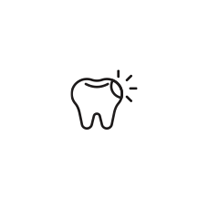Fillings

If you have tooth decay or a damaged tooth, then your dentist may recommend a filling.

The primary cause for tooth cavities is bacteria on the teeth due to a sugary diet that eventually erodes your enamel. However, tooth decay can also be caused by infrequent or improper teeth brushing, dry mouth, GERD (acid reflux), a lack of fluoride in your toothpaste among many other reasons.
Book
a Consultation
Click to send an email
Dental Fillings Oldham
Rhodes Street Dental is based in Oldham, Greater Manchester.
Composite Dental Fillings
In some cases, a composite filling will be performed on the NHS. In other instances, it will be considered a private treatment, especially if the cavity is towards the back of your teeth.
If you have a preference for a composite filling, please speak to us so we can advise you of your options.
Tooth Filling Cap
Placing a crown over a weakened tooth can prevent tooth breakage. Crowns are also used to restore stained or misshapen teeth, or to protect a tooth that has had a root canal. A crown may also be used instead of a filling, if your dentist deems the tooth doesn’t have enough structural integrity to hold a filling.
Cavity Filling Teeth Whitening
Amalgam Fillings
Typically, amalgam fillings are used on back teeth. The colour of amalgam is more noticeable than a composite (white) filling. However, composite fillings are not always available on the NHS, unless they are deemed clinically necessary.
Pregnancy may be a contraindication against amalgam fillings, though your dentist will advise you on the best solution.
Dental Temporary Fillings
Temporary fillings are only designed to be used on a short term basis. Therefore, we will arrange an appointment to fix your tooth permanently. While you wait for your permanent filling, you will need to be mindful of eating certain food and drinks which we will advise you of after your appointment.
FAQs
What happens during a dental filling?
Your dentist will first numb the area to make your filling procedure as comfortable as possible. This may involve an injection of local anaesthetic. Next, we’ll remove any decayed or damaged parts of your tooth. The remaining part of the tooth will then be shaped, cleaned and dried so that is ready to accept the filling.
Your cavity will be filled either with a composite or amalgam filling. The final stage is checking if your bite is correct when you put your teeth together.
Once your filling has been completed, you will need to continue looking after your oral health to prevent any future fillings. We may give you some advice relating to diet or brushing techniques to help you do this.
Attending regular dental checkups will also allow us to examine your fillings to make sure they are still intact, alongside inspecting your teeth and gums as a whole.
How are the teeth filled with the dental composite?
What is the difference between direct and indirect white fillings?
As a result, an impression or mould of your teeth is required and therefore the process is considerably longer. Indirect dental bonding is useful when large restorations are required in order to minimise the shrinkage caused during the curing and drying process. This type of bonding is also more common when fillings are needed for the posterior teeth.
Signs you may need a filling
- A hole or dark spot on your tooth
- A missing or broken filling
- Bad breath
- Tooth sensitivity or pain
While the above list is some of the most common signs you may need a filling, it’s by no means exhaustive. In many cases, patients only become aware they need a filling when they have a dental checkup. Therefore, please come and see us if you have any concerns about your teeth, or if it’s been longer than 12 months since you last had a dental checkup.
How do you prevent fillings?
We’re glad you asked! As mentioned, cavities or tooth breakage can mean you may require a filling to protect that tooth. While there are various causes of cavities, the number one reason is due to tooth decay.
Here are some of our top tips to prevent fillings in adults and children:
- Brush twice a day for 2 minutes with a fluoride toothpaste
- Floss and use interdental brushes daily
- Attend regular dental checkups
- Reduce or eliminate sugary foods
- Avoid fizzy drinks
- Avoid snacking between meals
- Avoid eating or drinking after you’ve brushed your teeth at night
- See your GP if you have a persistent dry mouth
What are the benefits over other types of fillings?
- They are more aesthetically pleasing
- They do not contain mercury
- Composite fillings are insulated
- Bond better to teeth helping to avoid breakage
- Can be repaired if damaged

